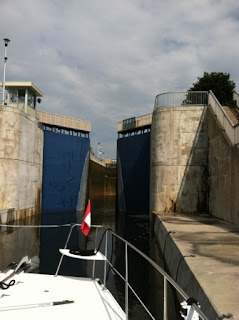We've washed up in another marina with WiFi and so have another chance to add to the blog.
From Hastings we traveled to Peterborough through Rice Lake. The lake was a nice wide body of water, but unfortunately sections of it were covered in weeds. We passed a boat that had anchored out in the lake, they were painstakingly picking weeds out of their anchor chain as they were raising their anchor. We sympathized with their plight, little realizing that a couple of miles later we'd be fighting to get weeds off of our own propellers. One of the lock tenders told us the combination of warm weather and less snow run-off than normal led to a bumper crop of weeds in the water this year.
Peterborough has a population of 75,000 so all of the services we needed were available. The town runs a marina that is conveniently located to groceries, liquor, restaurants, the farmer's market and the bus system for getting to outlying areas if needed. I even found a hairdresser to cover the grey and give my shaggy locks a trim. The staff at the marina were some of the friendliest and most helpful marina staff we have encountered in a very long time.
We've been leapfrogging a group of boaters we met in Brewerton, NY along the Trent Severn and most of us ended up in Peterborough at approximately the same time. Carolyn and Susan on Sojourner were just leaving as we arrived, Cate and Gorden on Viking Star and Scott and KC on Jet Stream were on the lock wall, and Eddie and Sandi on Tarquin arrived just as we were leaving. It is nice to have a little community of friends you can exchange tips and info with as you move on.
 |
| Viking Star |
 |
| Upper pan readying to lower |
 |
| View of the lock from the bottom |
 |
| Pans about to pass each other midway |
 |
| View from the top |
It was a grey day unfortunately, so you really can't get a sense of how high we were when we exited the lock, but the lift on this lock is 65 feet. You can watch the lock in action on this Lock 21 YouTube video.
We passed through another four locks and ended in Lakefield for the evening, where our friends Walter and Margaret Boswell from Cleveland joined us for the night. Unfortunately, it was raining and we didn't really have a chance to explore the town with them. They were on their way to Toronto to see War Horse (the play) and only spent the one night with us, but it was good to see them. We also ran into our old friend the Kawartha Voyageur cruise ship in Lakefield. That is one of the places it spends the night on its Trent Severn cruise.
We are in "cottage country", the area of the waterway close enough to Toronto for folks to keep weekend and vacation homes. The homes range from true cottages, small little waterfront places to monster homes that wouldn't be out of place on the waterway in Fort Lauderdale. These two typify the range of housing.
 |
| Cottage with plane |
 |
| Glass cube house |
We are also in houseboat country. Bobcaygeon (pronounced "Bob cajun") is the rental center for the three houseboat vendors on the Trent Severn Waterway. We've seen dozens of them in the last three days. Apparently those renters who decide to go south typically travel from Bobcaygeon to Peterborough on their holiday. I'm not sure where those who go north end up, but I'm sure we'll find out when we leave Bobcaygeon. As you might imagine, the lock tenders have a wealth of houseboater stories because most of these folks have no experience boating and/or locking. Even Jim now has a houseboater story because he rescued a flip-flop lost by a houseboater in a lock one afternoon.
 |
| Typical houseboat complete with slide |
We're cleaning the boat, taking on water and groceries, and anticipating the arrival of our friends Rob and Carol Harris from Miami. They will be traveling with us for a week. We're looking forward to the company.








